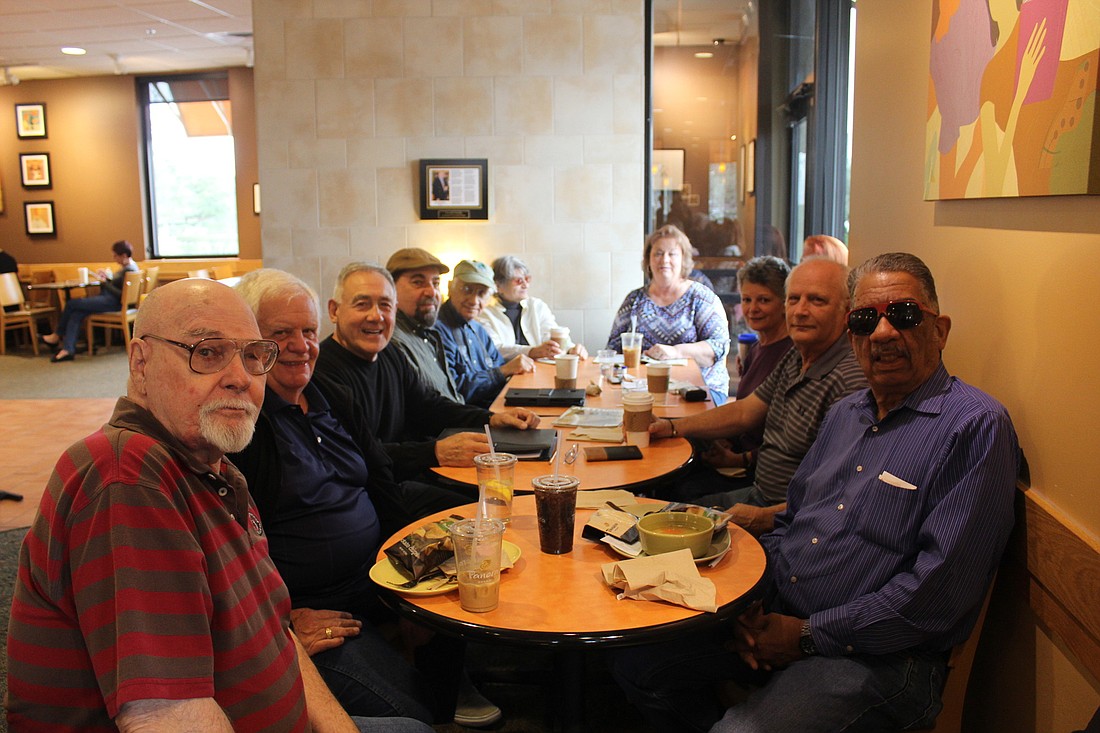- November 28, 2024
-
-
Loading

Loading

Nestled in the corner of Panera Bread off S.R. 100, you can find a group of nine individuals huddled so close together that you'd think they were related. And after a few moments of casual eavesdropping over their lunch, you'll learn that there's more to this gathering than just a meal.
"What was the original name of the group," Donald Kolberg asked the crowded table.
"The Intellectuals," answered Emile Dillon II, one of the founding members.
"No, no, no," Kolberg laughed and waved Dillon away. "We're so far from that."
With a group made up of professional artists, retired teachers and one member described as a "walking and talking art encyclopedia," they really aren't far from holding that title. However to coincide with the simplicity of their meetings, the nine artists chose "The Art Group" as their official name.
Defined by enjoyment not dues, as stated in their group biography, these local artists have been meeting weekly for three years, and have grown "without bylaws or procedures to hamper their lively conversations."
"There seemed to be something missing in the area," Kolberg said. "There are guilds and stuff, but they're very cliquish. We started with just a few people hanging out and talking about art. It was one table. Now it's three."
The three tables house many different forms of art. Everything from photorealistic to abstract to sculpture to wood carving is practiced and discussed during their meetings. Though they all work with different materials, it's their varying types of expertise that make the group so beneficial. If someone has a question, then someone is bound to have the answer.
"It gives you an outlet," said William Mazziotti," and as an artist you need that criticism, that constructive criticism to draw from."
Also in the spirit of keeping it simple, the group has only met to discuss their art, not show it as an organization — until now. The Art Group's first ever show, "Art x 9," will be held at The Casements in February. The artists will show different pieces of their current collections; the only theme being their own individuality.
"As a young man, I put it all in. As an older man, I'm taking it out, reducing the work to its basic elements. I want my paintings to have their primary voice through color.
So, while many of the works reflect social themes, and a few are exterior or interior landscapes, they are all about color and space."
Growing up in New Jersey, Dillon was raised by a family of artists, including his grandfather, Frank Joseph Dillon, a famous 20th century painter, and his uncle, Felix Vargas, a famous Latin American painter. In the 1970s, Emile Dillon started working for Eastman Kodak Company and became a photojournalist and an editorial photographer. In 1998, he went back to his first love, painting and studied at The School of Visual Arts and The Art Student League in New York City.
Elshant's art revolves around Mother Nature, and her inspiration is reflected in her work created from the wanderings throughout New England and Florida. She honors nature and hopes her art teaches people about respect and sensitivity that needs to exist between humans and our natural environment.
"My art creates happiness for the viewer that revolves around color and texture. Yet for me it represents a healing. The reason that I'm doing what I'm doing is to meet the challenge that cancer has brought to my life. The fight has been part of my life since 2009. So in creating beauty in art, I hope that what I do is share the hope and joy of living. Part of me goes into each piece leaving my touch on the world."
A Scottish born artist and crafter, Hammond likes to recycle old materials like wood, metal, hardware, canvases and any other form of matter that seemingly has no use anymore. He rescues the parts, cleans them up and gives them a new lease on life.
Kolberg graduated with a fine arts degree from California State University, has taught at the Los Angeles School of Art and co-found Art Core, an organization dedicated to the open dialogue of emerging artists. He learned the value of depth, texture and form in images and surface through the influence of internationally recognized painter Arnold Mesches. He incorporates these ideas into his concept of "Life Forms," the portrayal of the human figure as a landscape of life and a celebration of form capture in the new medium of steel mesh.
"For the past year and a half I have been working on a body of work titled the 'Waterfall Series.' In these pieces importance was placed on structure, space, materials and the application of paint to a chosen surface. By paying attention to how paint is applied, a texture is born."
"I work now as a 66 year old with zeal and curiosity. I have lived through many art movements and spend time in museums, art galleries, art venues and quirky art neighborhoods around the country and parts of the world. I have had my work characterized as 'Some weird synthetic Cubism,' and 'Folksy.' I don't really know that I fit in those categories given the vagaries of painting."
"These two-dimensional paintings made on canvas in the last two months of 2015 are part of my 'Color Moves/Ribbon Series.' They can be read as horizontal ribbons of ascending or descending movement. My interest in clear color began in 1970 and still dominates. At the same time placing one or more vertical bands of light and dark color offers the optional illusion of a fold or bend. Like the paintings, my titles are invented words."